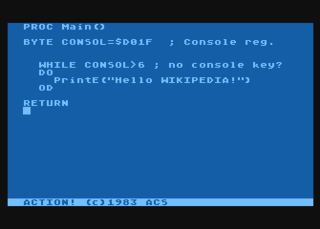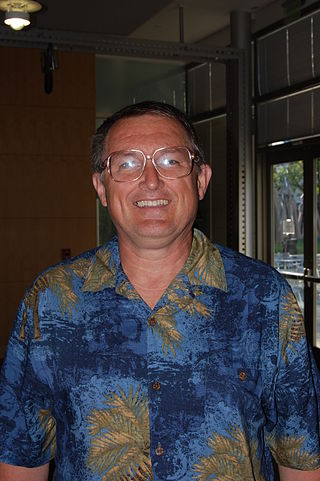Applesoft BASIC is a dialect of Microsoft BASIC, developed by Marc McDonald and Ric Weiland, supplied with Apple II computers. It supersedes Integer BASIC and is the BASIC in ROM in all Apple II series computers after the original Apple II model. It is also referred to as FP BASIC because of the Apple DOS command FP used to invoke it, instead of INT for Integer BASIC.

The Apple II is a personal computer released by Apple Inc. in June 1977. It was one of the first successful mass-produced microcomputer products and is widely regarded as one of the most important personal computers of all time due to its role in popularizing home computing and influencing later software development.
BBC BASIC is an interpreted version of the BASIC programming language. It was developed by Acorn Computers Ltd when they were selected by the BBC to supply the computer for their BBC Literacy Project in 1981.

The Atari 8-bit computers, formally launched as the Atari Home Computer System, are a series of home computers introduced by Atari, Inc., in 1979 with the Atari 400 and Atari 800. The architecture is designed around the 8-bit MOS Technology 6502 CPU and three custom coprocessors which provide support for sprites, smooth multidirectional scrolling, four channels of audio, and other features. The graphics and sound are more advanced than most of its contemporaries, and video games are a key part of the software library. The 1980 first-person space combat simulator Star Raiders is considered the platform's killer app.

Atari BASIC is an interpreter for the BASIC programming language that shipped with Atari 8-bit computers. Unlike most American BASICs of the home computer era, Atari BASIC is not a derivative of Microsoft BASIC and differs in significant ways. It includes keywords for Atari-specific features and lacks support for string arrays.
Microsoft BASIC is the foundation software product of the Microsoft company and evolved into a line of BASIC interpreters and compiler(s) adapted for many different microcomputers. It first appeared in 1975 as Altair BASIC, which was the first version of BASIC published by Microsoft as well as the first high-level programming language available for the Altair 8800 microcomputer.
Integer BASIC is a BASIC interpreter written by Steve Wozniak for the Apple I and Apple II computers. Originally available on cassette for the Apple I in 1976, then included in ROM on the Apple II from its release in 1977, it was the first version of BASIC used by many early home computer owners.
Commodore BASIC, also known as PET BASIC or CBM-BASIC, is the dialect of the BASIC programming language used in Commodore International's 8-bit home computer line, stretching from the PET (1977) to the Commodore 128 (1985).

Action! is a procedural programming language and integrated development environment written by Clinton Parker for the Atari 8-bit computers. The language, which is similar to ALGOL, compiles to high-performance code for the MOS Technology 6502 of the Atari computers. Action! was distributed on ROM cartridge by Optimized Systems Software starting in 1983. It was one of the company's first bank-switched 16 kB "Super Cartridges". The runtime library is stored in the cartridge; to make a standalone application requires the Action! Toolkit which was sold separately by OSS.
SWEET16 is an interpreted byte-code instruction set invented by Steve Wozniak and implemented as part of the Integer BASIC ROM in the Apple II computers. It was created because Wozniak needed to manipulate 16-bit pointer data, and the Apple II was an 8-bit computer.
The Mensch Computer is a personal computer system produced by the Western Design Center (WDC). It is based on the WDC 65C265 microcontroller, which implements the instruction sets of two microprocessors: the 16-bit W65C816/65816, and the 8-bit 6502. The computer is named after Bill Mensch, designer of the 6502 and subsequent series of microprocessor.

Randall Hyde is best known as the author of The Art of Assembly Language, a popular book on assembly language programming. He created the Lisa assembler in the late 1970s and developed the High Level Assembly (HLA) language.
Optimized Systems Software (OSS) was a company that produced disk operating systems, programming languages with integrated development environments, and applications primarily for Atari 8-bit computers. The founders of OSS previously developed Atari DOS, Atari BASIC, and the Atari Assembler Editor for Atari, Inc., and many OSS products are substantially improved versions. OS A+ and DOS XL are based on Atari DOS. BASIC A+, BASIC XL, and BASIC XE are based on Atari BASIC. EASMD and MAC/65 are modeled on the Atari Assembler Editor. Action! is an ALGOL-inspired compiled programming language with an integrated full-screen editor. OSS also sold some software for the Apple II.
Atari Assembler Editor is a ROM cartridge-based development system released by Atari, Inc. in 1981. It is used to edit, assemble, and debug 6502 programs for Atari 8-bit computers without the need for additional tools. It was programmed by Kathleen O'Brien of Shepardson Microsystems, the company which wrote Atari BASIC, and Assembler Editor shares many design concepts with that language implementation.

The Tangerine Microtan 65 was a 6502-based single board microcomputer, first sold in 1979, that could be expanded into, what was for its day, a comprehensive and powerful system. The design became the basis for what later became the Oric Atmos and later computers. Those later machines have similar keyboard addressing and tape I/O as the Microtan 65. The Microtan 65 has a hardware single step function that can be used for debugging software in both ROM and RAM. The computer was available as ready-built boards or as kits consisting of board and components requiring soldering together.

The Machine Operating System (MOS) or OS is a discontinued computer operating system (OS) used in Acorn Computers' BBC computer range. It included support for four-channel sound, graphics, file system abstraction, and digital and analogue input/output (I/O) including a daisy-chained expansion bus. The system was single-tasking, monolithic and non-reentrant.
Apple II graphics debuted on the original Apple II in 1977 and were used throughout the computer series of the same name. The graphics consist of a 16 color low-resolution mode and a high-resolution mode where visuals are dependent on artifact color. The Apple IIe added "double" versions of each of these, most prominently "double high-resolution" with twice the horizontal resolution in 16 colors. Internally, Apple II graphics modes are idiosyncratic and do not use a linear frame buffer.

The ITT 2020 was an Apple II computer clone manufactured by ITT under license from Apple Computer, specifically for the European market. In the Benelux, it was distributed by International Bell Telephone Company. It was distributed in the United Kingdom by Microsense Computer Limited.

The Gigatron TTL is a retro-style 8-bit computer, where the CPU is implemented by a set of TTL chips instead of a single microprocessor, imitating the hardware present in early arcades. Its target is the computing enthusiasts, for studying or hobby purposes.

A BASIC interpreter is an interpreter that enables users to enter and run programs in the BASIC language and was, for the first part of the microcomputer era, the default application that computers would launch. Users were expected to use the BASIC interpreter to type in programs or to load programs from storage.









